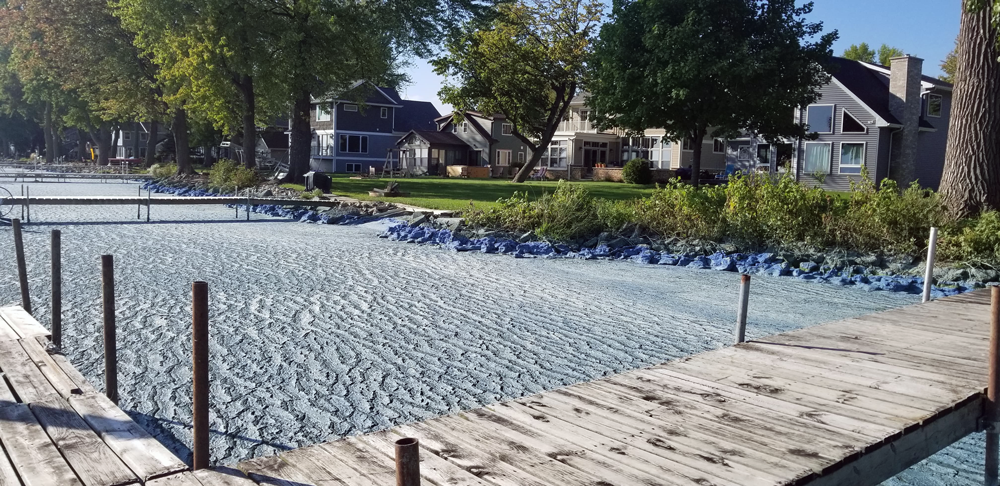Although it’s winter and the lakes are frozen over, the thick green, smelly algae blooms are still a recent memory for many of us who like to spend time boating or swimming in the Winnebago System. The combination of high temperatures and phosphorus resulted in the Winnebago Lakes looking like what many described as ‘pea soup’. On the north end of Lake Winnebago, the algae formed a blue mat on the surface so thick it looked like you might be able to walk across it. Not only does algae smell horrific, blue-green algae has the potential to release toxins that are harmful to humans and animals (including pets!).
While algae are a healthy part of a natural lake system in small amounts, the severe blooms we see in the Winnebago Lakes are evidence that our lakes are out of balance. The lakes have too much phosphorus and not enough aquatic plants to use it. The Winnebago Waterways Lake Management Planning team is developing recommendations to get our lakes back into balance by:
(1) reducing agriculture and urban nutrient runoff
(2) restoring aquatic plants.
Over the past several decades, the lakes have seen a major loss of aquatic plants because of high water levels and erosion. Aquatic plants take-up phosphorus and anchor the sediment. A water level strategy that will allow aquatic plants to grow would help reduce the amount of phosphorus available to algae. This strategy implemented consistently over multiple years along with a reduction of nutrient runoff from the landscape would reduce the frequency and severity of algae blooms.
Water levels in Lake Winnebago are artificially controlled by two dams: one in Neenah (privately owned) and one in Menasha. The dam in Menasha is operated by the Army Corps of Engineers. As part of the Lake Management Planning process, a group of representatives from the system met to discuss and develop a slightly modified water level strategy for Lake Winnebago to try to increase the amount of plants. The proposed strategy was presented to the Army Corps of Engineers toward the end of 2018.
Recommendations include:
- Shift summer water level target range down 1.2 inches.
- Hold water levels toward the lower end of the target range, when possible.
- Extend summer water level target through October for fall boating.
- Shrink winter drawdown target range.
- Form an ongoing committee made up of diverse stakeholders to review lake conditions and provide input to the Army Corps prior to the spring refill, fall regulation, and winter drawdown meetings.
Read more about the recommendations HERE
The Army Corps is holding a public meeting to allow members of the public to discuss and provide input on that proposed modified strategy on Thursday, January 17th, 2019 at 6:00pm in Appleton at the Army Corps Office (2619 E. Capitol Drive). You can view their full public meeting notice HERE.
Recreation is an important part of our lakes, our regional identity, and local economy. We understand that aquatic plants can be a nuisance to recreation in certain areas so we are working to develop strategies to deal with plants in the lakes in places where they might impede navigation or other activities (such as swimming).
Ultimately, our goal is improved water quality and a healthier lake system.
Questions? Comments? Contact Korin Doering at (920) 851-0948 or korin@fwwa.org
Winnebago Waterways is a Fox-Wolf Watershed Alliance program. The Fox-Wolf Watershed Alliance is an independent nonprofit organization that identifies and advocates effective policies and actions that protect, restore, and sustain water resources in the Fox-Wolf River Basin.



I have fished this lake for 30 plus years. There is more plant life now than there was 30 years ago in my opinion. There are weed beds now that did not exist years ago. In fact, the eccessive weed issue was a huge complaint by some just a few years ago and still is for some. The water is much clearer now too. We have had these blooms for years and I am in full support of reducing runoff. I question the usefulness of the level reduction, especially at the cost of reduced navigation. It is a shallow lake and every inch matters. Stop the problem at the source… runoff.
Thank you for your comment, Dave. We agree – runoff is a major problem! We need to prevent the phosphorus from entering our system by improving agricultural practices and getting people to be better stewards in our urban areas. This is why we are developing watershed plans for 30 watersheds in the Winnebago Region as part of the lake management planning effort. The runoff isn’t the only source of phosphorus in our lakes though. Internal loading of legacy phosphorus is a big source of available phosphorus during the growing season. This is because the wind and waves stir up the bottom sediment where decades of phosphorus pollution is stored. The phosphorus gets suspended and becomes available as a source of fuel for algae. If we were to completely stop all runoff from entering our lakes, we will still have 75+ years of too much phosphorus because of what is already stored in the bottom of the lake. We need to find ways to both reduce runoff and stabilize the sediments. The slight alteration of the water level strategy is only one piece of the large puzzle. It will take a variety of strategies over several years to improve the health of our lakes.